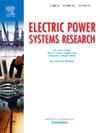Passive modeling of transmission line impedance with real poles using non-negative least squares
IF 4.2
3区 工程技术
Q2 ENGINEERING, ELECTRICAL & ELECTRONIC
引用次数: 0
Abstract
Rational function-based approximations are widely used to model frequency-dependent effects on power system components. In transmission line (TL) modeling, for example, series impedance behavior can be synthesized using these models for time-domain simulations. Due to its characteristics, the rational approximation of this impedance can be carried out with only real poles. Two rational fitting techniques are considered and compared, ensuring real poles: Vector Fitting-Real Poles (VF-RP) and Taku Noda’s (TN) method. A fitting methodology based on residue calculation via Non-negative Least Squares (NNLS) is presented, which can be implemented in both fitters to obtain models that guarantee passivity. The advantages of the proposed methodology are demonstrated for (1) synthesizing the series impedance of a single-phase transmission line and (2) synthesizing the series impedance matrix of a three-phase double-circuit horizontal transmission line, where the concept of common poles is also implemented. The results show that the proposed methodology makes it possible to guarantee the passivity of the impedance model.
用非负最小二乘法对具有实极的传输线阻抗进行无源建模
基于有理函数的近似被广泛用于电力系统组件频率相关影响的建模。例如,在传输线(TL)建模中,串联阻抗行为可以利用这些模型进行时域仿真。由于其特性,该阻抗的合理近似可以只用实极进行。考虑并比较了两种保证实极点的合理拟合方法:向量拟合-实极点法(VF-RP)和Taku Noda法(TN)。提出了一种基于非负最小二乘残差计算的拟合方法,该方法可在两种滤波器中实现,以获得保证无源性的模型。该方法的优点被证明:(1)综合单相传输线的串联阻抗,(2)综合三相双回水平传输线的串联阻抗矩阵,其中也实现了共极的概念。结果表明,该方法可以保证阻抗模型的无源性。
本文章由计算机程序翻译,如有差异,请以英文原文为准。
求助全文
约1分钟内获得全文
求助全文
来源期刊

Electric Power Systems Research
工程技术-工程:电子与电气
CiteScore
7.50
自引率
17.90%
发文量
963
审稿时长
3.8 months
期刊介绍:
Electric Power Systems Research is an international medium for the publication of original papers concerned with the generation, transmission, distribution and utilization of electrical energy. The journal aims at presenting important results of work in this field, whether in the form of applied research, development of new procedures or components, orginal application of existing knowledge or new designapproaches. The scope of Electric Power Systems Research is broad, encompassing all aspects of electric power systems. The following list of topics is not intended to be exhaustive, but rather to indicate topics that fall within the journal purview.
• Generation techniques ranging from advances in conventional electromechanical methods, through nuclear power generation, to renewable energy generation.
• Transmission, spanning the broad area from UHV (ac and dc) to network operation and protection, line routing and design.
• Substation work: equipment design, protection and control systems.
• Distribution techniques, equipment development, and smart grids.
• The utilization area from energy efficiency to distributed load levelling techniques.
• Systems studies including control techniques, planning, optimization methods, stability, security assessment and insulation coordination.
 求助内容:
求助内容: 应助结果提醒方式:
应助结果提醒方式:


